From the serene ski slopes to the vibrant city lights, Japan offers a diverse and enchanting experience.

Where I stayed:
During my visit, I stayed at two different hotels: The Hilton in Hokkaido, located conveniently next to the ski lift on Niseko Mountain, and the chic Bespoke Hotel in Shinjuku, Tokyo, a stylish haven in the heart of the city.
What I Did:
Arrival and Ski Adventure:
The adventure kicked off with a seamless transfer from Tokyo Narita to Haneda Airport, leading to a quick flight to Sapporo and a shuttle ride to the Hilton in Niseko.
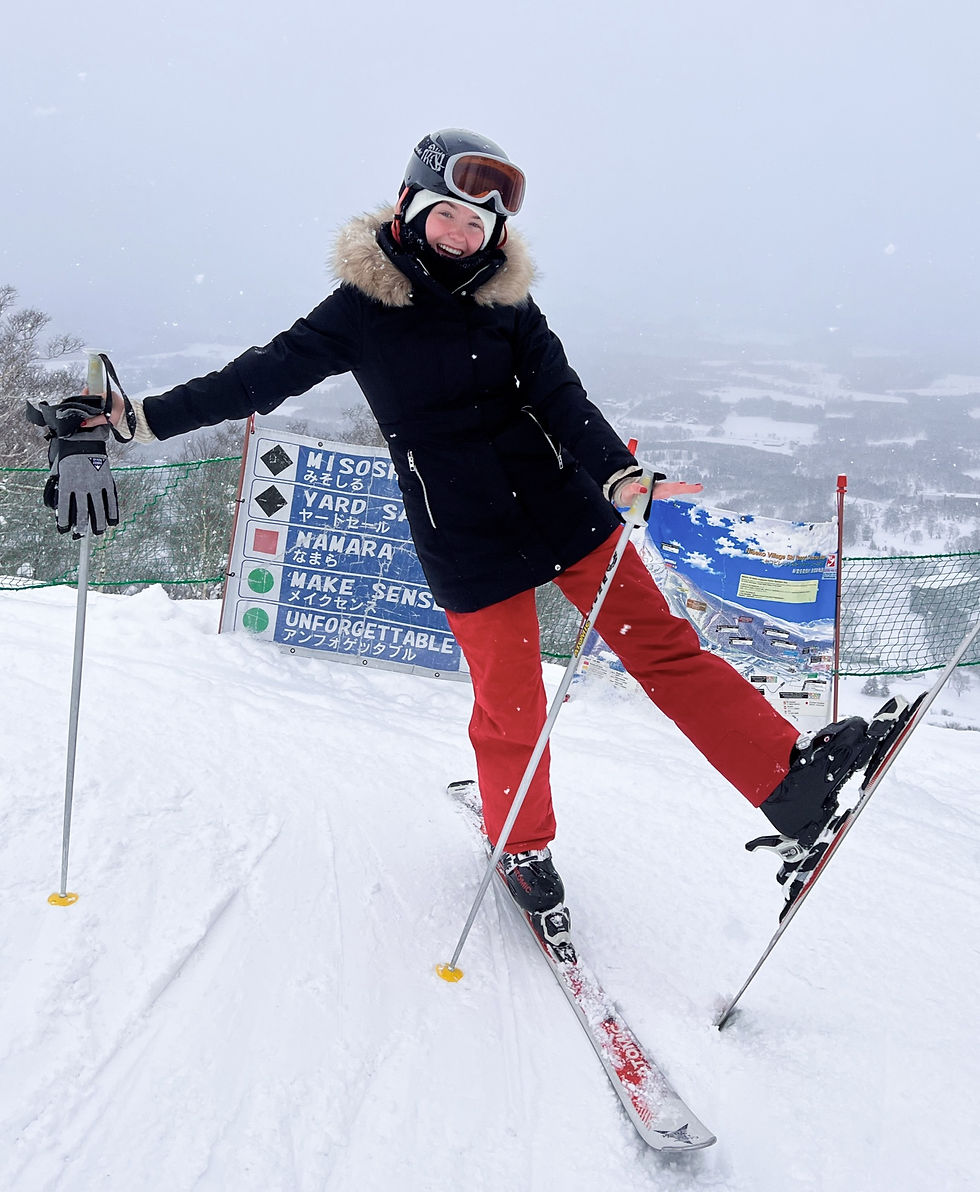
Equipping myself with rented ski gear, I delighted in two days of skiing in Niseko's diverse trails.
The Hilton is located adjacent to the lift and offers ski rental storage and a large seating area–perfect for a hot chocolate break.
The hotel offered festive buffets and restaurants, featuring a consistent snowfall during December and January with beautiful views from the large windows in the hotel.

The Hilton Hotel not only provided a remarkable ski experience but also boasted separate women's and men's onsens, perfect for unwinding after a day on the slopes. Just be prepared to strip down first! The hotel also offers other activities (separate shopping and dining village, sledding, snowmobiling, free shuttles to other mountain resorts and amenities as well as nightly live entertainment. After 2 full days of my skiing adventure, I headed back to Sapporo airport to arrive back in Tokyo!
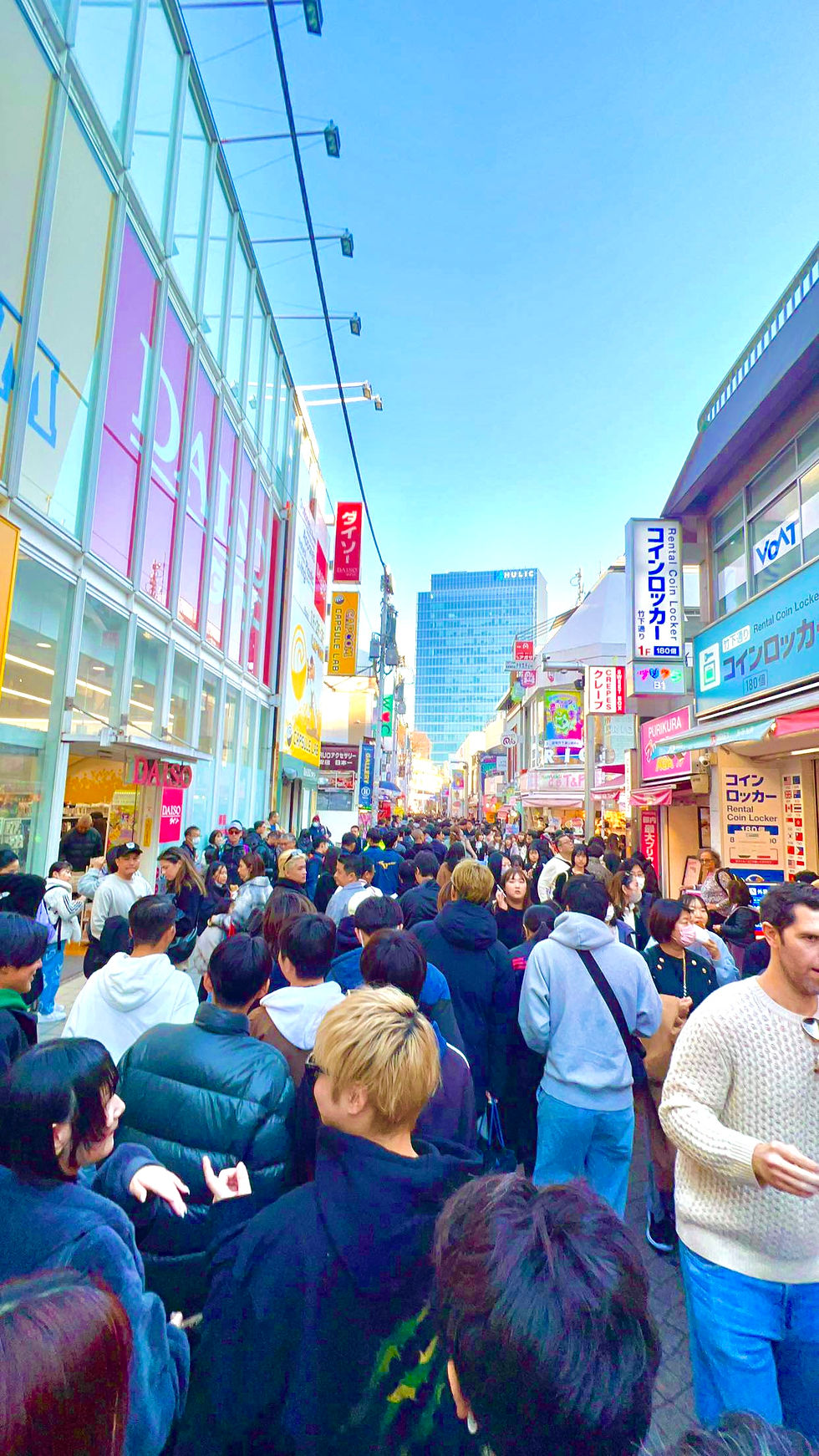
Exploring Tokyo's Vibrant Lights and Attractions: A return to Tokyo marked a shift to urban exploration. Armed with a 5-day pass on the JR East line, easily accessible at the Tourist Center, Tokyo's main attractions were just a few train stops away. There are stations all over the city, and trains run through every few minutes to pretty much any area you’d like to go.
The Shinjuku station was about a 10-minute walk from my hotel, and I easily memorized the route by my third day.
The JR East Pass will also allow you to explore other areas surrounding Tokyo, including Mt. Fuji and Nagano.
There are many directional signs, written in both Japanese and English, that ensure easy navigation throughout the city.

During my stay, I was able to explore different parts of the city, including Shinjuku (including the famous Harajuku area), Shibuya, Roppongi, and Odaiba. Shinjuku is a larger part of Tokyo with many sights to see, and I started my visit with a walk along its famous Takeshita Street.
There were many sweet shops, clothing boutiques and animal cafes, so I delighted in some cotton candy and played with some adorable puppies. If you want to ensure that you visit an ethical animal café, make sure to do your research in advance!

There are many crowded streets in Tokyo, but you’ll never be far from peaceful tree-lined walkways and protected Temples and Shrines in the middle of the city, so don’t be too worried if you get anxious navigating large crowds. The city lights and culture can be overwhelming in its many offerings, but people are very respectful and much more spatially aware than most other crowded cities I’ve visited.

Two major tips I have for visiting Tokyo are: 1.) Don’t litter!!! and 2.) Be mindful of speaking quietly on public transportation. The city is extremely clean, but there are few trash cans available in public. People are expected to hold their trash until they can dispose of it, so make sure to limit possible garbage.
Also, travelers are expected to remain quiet on public transportation, so it’s considered rude to make a phone call or use a loud tone in your voice – these two tips are incredibly important for tourists.

Shibuya Scramble Crossing:
At the biggest crosswalk in all of Tokyo, up to 2,500 people traverse at once at the Shibuya Crossing. This intersection is near the Hachiko Dog statue, which is also a famous landmark in Shibuya. There are many books and articles written about this sweet dog’s relationship with his owner—look it up! And speaking of looking up, make sure to look up at the various billboards flanking the Shibuya Crossing. It’s a picture-perfect scene of modern Tokyo. There are dozens of up-scale shops, high-end restaurants, art galleries, unique buildings and famous destinations in this popular urban area. It can get crowded, but there is always something to do or see right around the corner. Even just roaming around can lead to a fun adventure in this area.

Anakuma Café:
This iconic cafe, which means “bear in a hole” in Japanese, is located in Harajuku and is known for its unique way to retrieve your drink. There are many different options, like coffee, tea and juice that you’ll get with no real human interaction.
The “bear” writes fun questions and facts on a little chalkboard and can speak English. You receive your drink from the bear claw and it’s an adorable and different type of café that is incredibly well-known. Definitely guaranteed to warm you up and put a smile on your face. The entire area is joyful, with its kaleidoscope of colors.

Hedgehog Café:
Animal cafes are extremely popular in Tokyo, offering a wide range of animals from otters, dogs, cats, capybaras, and even mini pigs.
Visiting any of these cafes, specifically the Hedgehog Cafe in Shibuya, is a must.

When I visited this cute little place, I delighted in holding and feeding hedgehogs, playing with hamsters and even hanging out with a curious meerkat!
Most of these cafes take reservations, and I highly recommend carving out some time for this activity.
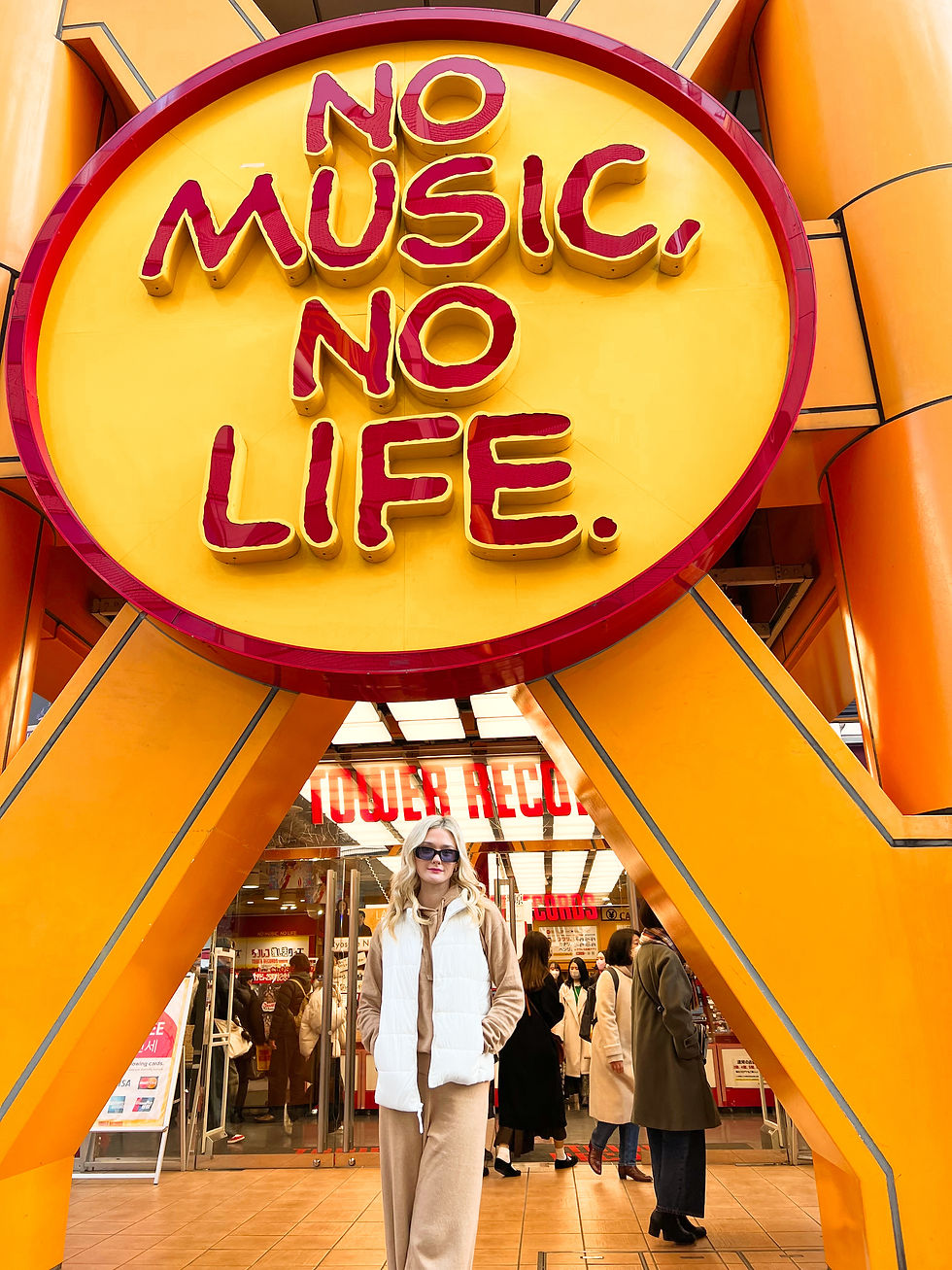
Tower Records & Rainbow Karaoke
The iconic Tower Records is widely known for being the largest record store in Japan. It’s a whopping 9-stories tall! Inside, there is a variety of music ranging from J-Pop to Taylor Swift. It even hosts live music events.

American music is quite popular in Japan, and so is karaoke! There are many spots that offer this activity, and I chose to visit Rainbow Karaoke. There are private rooms (one even has instruments where you can form your own band!) where you can order food and drinks and enjoy karaoke with a group! Most of the niche American songs we chose were on the list, so definitely check out this fun experience!

Japanese Arcades:
Tokyo is home to a variety of arcades with classic games (Mario Kart) and interactive experiences (Dance Dance Revolution). You can stop in for an hour or even make a day of it. If you’re in for the full experience, consider taking a train across the Rainbow Bridge and invest in a day pass at Joypolis in Minato City near Tokyo Beach.
Joypolis is filled with indoor roller coasters, interactive experiences, classic and new arcade games and dining options. It’s in an entertainment complex, which includes shopping, restaurants, movie theaters, museums, social media photo ops and an amazing view of the illuminated Rainbow Bridge at night. If you’re traveling with teens or younger children, it’s a nice break from sightseeing and a good alternative to traditional amusement parks like Tokyo Disney.

Tokyo Pub Crawl:
Indulging in nightlife in Roppongi added a “spirited" component to my trip. Starting at Shot Bar Propaganda and winding through three bars and one club, Tokyo Pub Crawl (I booked through Viator) offers English-speaking tours every Friday and Saturday night.
For its modest price, this well-organized tour not only facilitated new friendships with other foreign tourists (in my case, Australians on summer break) but also included complimentary drinks.
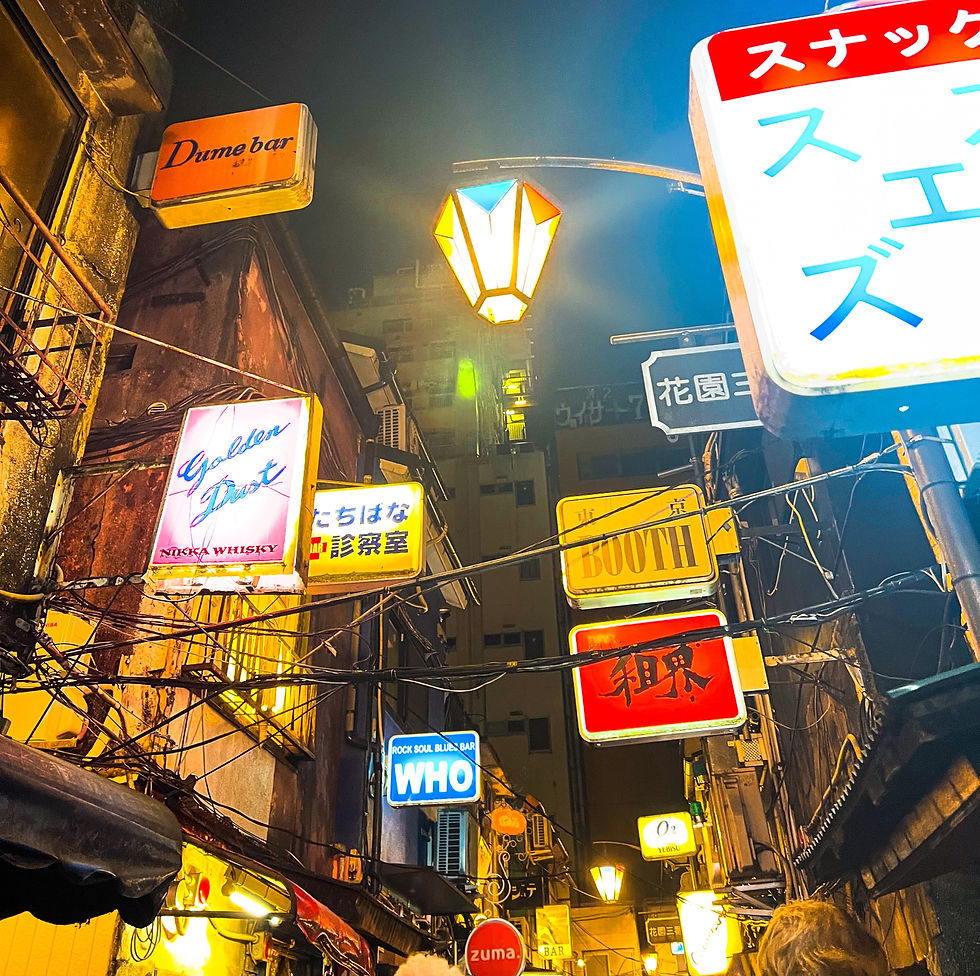
Golden Gai:
At night, all of Tokyo lights up. Oversized billboards display bright animations, and street shops illuminate their neon lights.
The nightlife in Tokyo is breathtaking and in a small area of Shinjuku adjacent to my hotel, there is a collection of smaller bars and pubs in a place called Golden Gai.

Many of these bars waive their cover charge for tourists and welcome visitors. But make sure you don’t see a "No Gaijin” sign displayed in the window. Those bars are reserved for locals.
Most of the bars offer very few seats (usually 6-8 stools), but it’s the perfect size to meet a friend, enjoy a Japanese whiskey and move on to another establishment.

The biggest bar in Golden Gai seats around 20. Golden Gai is liveliest on weekends, and some offer more traditional Japanese cocktails, such as the snakeskin sake shots I tried at a pub called Reno.
The entire area feels like a step back in time compared to the modernity of surrounding Tokyo. This was one of my favorite parts of the trip, so check it out if you have time!

Bullet Train Adventure to Nagano & Snow Monkey Park
The Shinkansen (Bullet Train) journey to Nagano opened doors to a day tour filled with adventure.
Nagano was where the 1998 Winter Olympics were held, and there were many snow activities to experience.

Snow biking and sledding was a great start to a fantastic day in the region, where I also enjoyed local cuisine and a a scenic lift to the mountain's foggy peak.
The venture up to the Snow Monkey Park was the most unforgettable part of the day, where I was surrounded by macaque monkeys enjoying hot springs, and they are known to be one of the few breeds of monkeys that enjoy a water habitat.

As wild monkeys in a protected park, the macaques interact with humans during the daytime, and at night venture to the depths of the cold forest.
It is about a mile to hike to the hot springs, and it can get muddy if the temperatures rise, so make sure to wear shoes and pants that you wouldn’t mind getting a little dirty.
The snow monkeys are so playful, it’s definitely worth the trek!
One last piece of advice: remember to bring your winter coat and hat if you are visiting in the winter months, as it tends to be pretty cold near the mountains.

New Year's Eve Traditions:
Returning to Tokyo, New Year's Eve brought unique traditions. In Japan, New Year’s Eve is less about fireworks and revelry and more about time for family, quiet reflection and ringing bells in anticipation of the year ahead. In honor of this tradition, I visited the Hanazono Shrine near my hotel where I committed more resolutions to writing (which included more travel!) and enjoyed the communal atmosphere, which involved local families in traditional dress accompanied by drum performances.

Such a memorable transition into 2024! There are celebrations across the city for this holiday, which was a special time to experience Tokyo. Learning and understanding the culture of this country by sharing it with local residents was a unique and unforgettable experience.
What I wore:
Packing strategically for the diverse climates throughout 10 days, I relied on a single backpack from Amazon, called the Matein Travel Backpack. It is very spacious with many different pockets, and it unzips like a suitcase–perfect for packing thicker clothes.

In Niseko for skiing, I wore lots of layers, and packed a combination of long sleeve shirts, stylish sweater sets, leggings and sweatpants. I also couldn’t forget my winter hat, fuzzy socks, or Zara winter coat, perfect for the snow. These pieces were also very helpful for my snow-monkey adventure in Nagano. And I packed my handwarmers, which came in “handy” during this part of my trip. Fortunately, I was also able to rent a few key pieces at the slopes so I didn’t need to carry bulky gloves, ski pants and goggles in my luggage.

Winter in Tokyo has similar weather to New York, so layers are very important. In the sun, you could be a little toasty, but in the shade with the wind you’ll want to make sure to wear a jacket.
Mixing and matching long sleeve shirts, comfortable sweatpants, sweaters, and jeans, I ensured both style and comfort on my trip, sticking to a color-scheme throughout my wardrobe.
And I elevated my looks with loads of accessories and fun sunglasses. Three pairs of shoes, including sneakers, wool-lined wedges, and waterproof wedges, covered all footwear bases.

Luckily, my mom and I wear the same size, so sharing shoes and clothes was also essential in how we were able to pack lightly.
Another key packing win—the Tokyo hotel offered laundry facilities laundry, so I was able to get a few loads washed in the evenings so I could refresh my wardrobe. But if you run out of something, just visit a local Don Quixote.
Not only is it a dazzling retail tourist experience, it literally has everything you might need for your travels!

What I ate/drank:
On almost every street in Tokyo, you will find unique plastic food displays of items on the menu – yes, you read that correctly. These unique displays were an interesting touch to the food culture in Japan.

The drinking age in Japan is 20, and it offers so many different types of food, from sushi to ramen to international fast food. I ran out of time on this trip, but I definitely recommend visiting Kura Sushi.
It is home to the world’s largest sushi conveyor belt and, after your meal, you can enjoy a trip to the top of nearby Tokyo Skytree for a stunning view of the city.

Japanese cuisine is so fresh and well prepared that it seems impossible to have a bad meal.
I had the opportunity to try Japanese sake for the first time, enjoyed Christmas dinner with sizzling wagyu and succulent crab in hot pots, indulged in countless bowls of ramen, and freshly prepared “on-the-go” snacks from local markets .
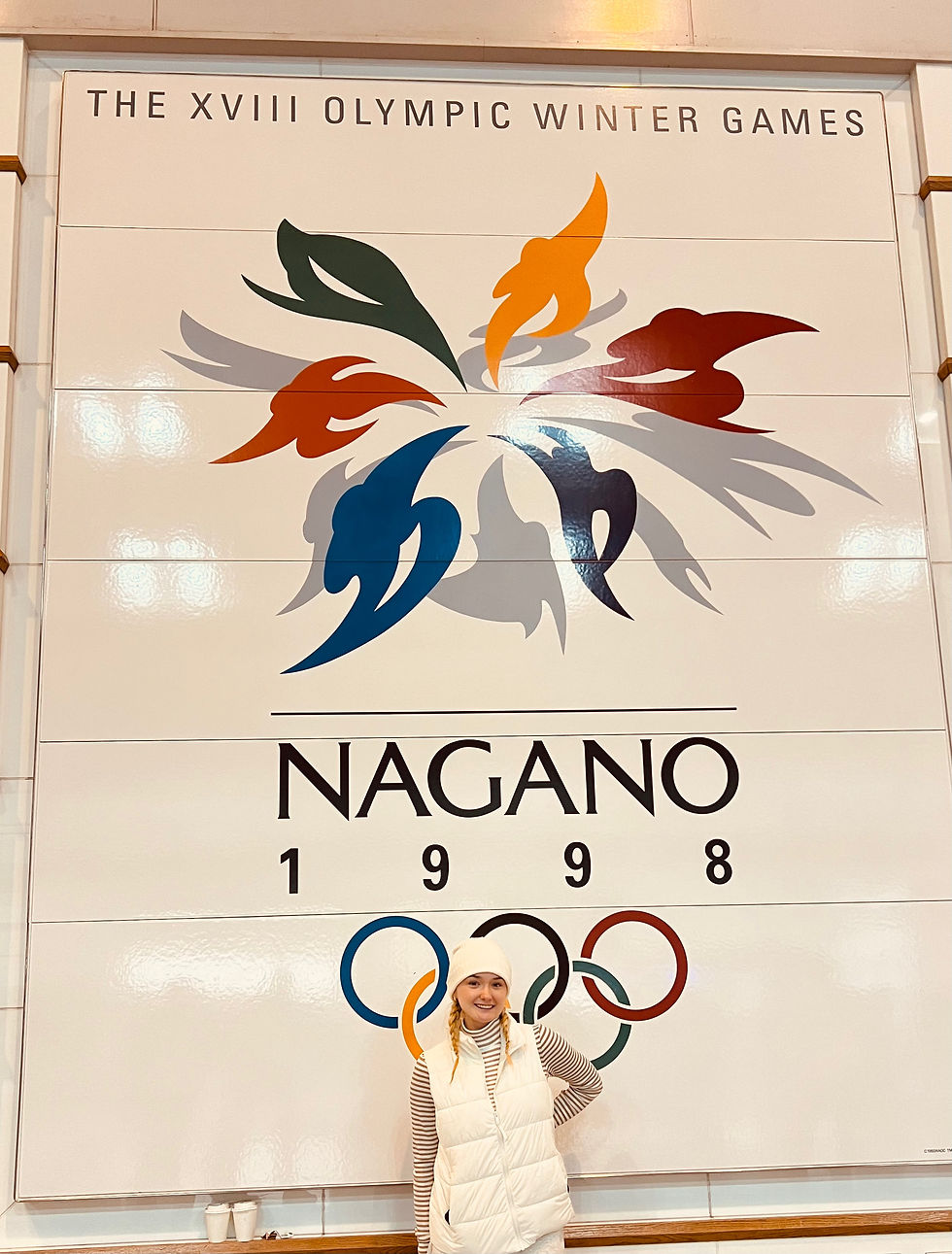
Whether you’re visiting Japan for a few days or a few months, you will never be bored of the fantastic activities, lively culture, amazing food and easy accessibility that this country offers.
The people are incredibly respectful, most places take Japanese Yen or credit cards, the transportation is easy to navigate, and the experience is like no other!

My Travel Playlist:


Comentarios